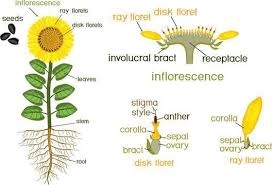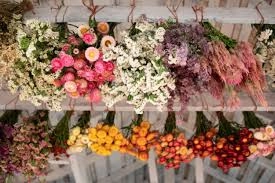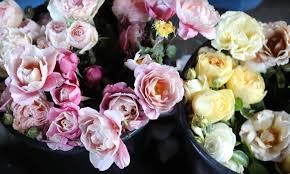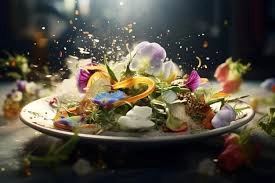Exploring The Floret Joy A Ultimate Comprehensive Guide isn’t just about admiring their beauty—it’s about understanding the science behind them, learning how to care for them, and finding ways to incorporate them into our daily lives for a touch of natural joy. Florets, with their delicate forms and vivid colors, are nature’s way of adding beauty and vibrance to our lives. From the humble daisy to the exotic orchid, these small but mighty floral structures play a crucial role in both the plant’s reproductive cycle and in our everyday aesthetics.
Whether you’re an avid gardener, a floral enthusiast, or someone just starting to appreciate the simple beauty of flowers, this guide will take you through everything you need to know about florets. From their biology and symbolism to practical tips on growing and arranging them, you’ll gain a deeper appreciation for these miniature wonders.
Understanding Florets: The Building Blocks of Blooms

Florets are often overshadowed by the larger, more showy petals of flowers, but they are the true stars of the botanical world. They are the small flowers that make up the clusters in larger composite flowers like sunflowers, daisies, and chrysanthemums. Each floret is a complete flower on its own, with its reproductive organs, though they often work together to create the flower’s overall visual impact.
Biology of Florets
The structure of a floret is fascinating. Typically, a floret consists of petals (known as corolla), sepals (collectively called calyx), stamens (male reproductive part), and pistils (female reproductive part). The role of each component is integral to the plant’s reproductive process. The petals attract pollinators like bees and butterflies, while the stamens and pistils facilitate the actual process of pollination.
In composite flowers, florets are usually found in two forms: disc florets and ray florets. Disc florets are tubular and usually found in the center of the flower head, while ray florets are flat and form the “petals” that radiate outwards. This arrangement is not just beautiful—it’s also incredibly efficient in attracting pollinators and maximizing the plant’s reproductive success.
Symbolism and Cultural Significance
Florets have been part of human culture for centuries, symbolizing everything from love and purity to death and rebirth. The floret’s small size belies its powerful symbolism in various cultures. For instance, the daisy, with its bright yellow disc florets and white ray florets, is often associated with innocence and purity in Western cultures. In contrast, the marigold, rich in vibrant yellow and orange florets, symbolizes both passion and the transient nature of life in many South Asian traditions.
Exploring the symbolism of different florets can add depth to your floral arrangements or garden planning. Whether you’re selecting flowers for a wedding, a memorial, or simply to brighten up your home, understanding the meanings behind them can help you convey the right message.
The Art of Growing Florets: Tips for Gardeners
Growing florets can be a rewarding hobby, whether you’re cultivating them in a sprawling garden or a small urban balcony. With the right care, these tiny blooms can bring an explosion of color and life to any space.
Choosing the Right Florets for Your Garden
The first step in growing florets is choosing the right types for your environment. Consider factors such as climate, soil type, and sunlight when selecting which florets to plant. For example, sunflowers, which are composed of thousands of tiny florets, thrive in full sun and well-drained soil. In contrast, violets prefer a bit of shade and moist, rich soil.
Additionally, think about the role you want these florets to play in your garden. Are you looking to attract pollinators? If so, opt for species with brightly colored florets, like coneflowers or zinnias. Or perhaps you want to create a ground cover of tiny, delicate blooms? Then, consider low-growing plants like alyssum or creeping thyme, which are covered in small, fragrant florets.
Planting and Care
Once you’ve chosen your florets, planting them properly is key to their success. Most florets are planted from seeds, though some can be propagated from cuttings or purchased as young plants. Make sure to plant them in well-prepared soil, enriched with compost to provide the necessary nutrients.
Watering is critical, especially in the early stages of growth. While most florets need regular watering, be careful not to overwater, as this can lead to root rot. As the plants grow, they may require staking, especially if they produce large flower heads made up of many florets, like sunflowers or dahlias.
Regular deadheading, or the removal of spent flowers, can encourage your plants to produce more florets, extending the blooming season. Also, be mindful of pests and diseases, which can damage your florets. Regular inspections and organic treatments like neem oil can help keep your plants healthy.
Seasonal Care
Florets have different needs depending on the season. Spring and summer are the prime blooming times for most species, so regular watering, fertilizing, and deadheading are important during these months. As the weather cools in autumn, many florets will go to seed. Collect these seeds for next year’s planting, or allow them to self-sow if you prefer a more natural garden aesthetic.
In winter, most florets will die back, especially in colder climates. However, you can prepare for the next growing season by mulching your garden beds, which will protect the roots of perennial plants and add nutrients to the soil.
Floret Arrangements: Bringing Natural Beauty Indoors

One of the joys of exploring floret joy is bringing these beautiful blooms into your home. Whether you’re arranging them in a vase or creating a more intricate floral display, the possibilities are endless.
Basic Principles of Floral Arrangement
Creating a beautiful floret arrangement starts with understanding some basic principles of design, such as balance, proportion, and harmony. Choose a mix of florets with different sizes, shapes, and colors to create interest. For instance, pairing the large, bold florets of dahlias with the small, delicate florets of baby’s breath can create a visually striking contrast.
Consider the shape and size of your container as well. A tall, narrow vase is perfect for showcasing long-stemmed florets like lilies, while a low, wide bowl might be better suited for a compact, lush arrangement of peonies and roses.
Seasonal Floret Arrangements
Each season brings its unique palette of florets, and your arrangements can reflect these natural changes. In spring, opt for soft pastels and fresh greens, using florets like tulips, daffodils, and hyacinths. Summer calls for bold, vibrant colors—think sunflowers, zinnias, and marigolds. In autumn, embrace warm tones with chrysanthemums, asters, and ornamental grasses. Winter arrangements can be more subdued, featuring evergreens, holly, and the few florets that bloom in colder weather, like hellebores.
Tips for Long-Lasting Arrangements
To ensure your floret arrangements stay fresh as long as possible, start by cutting the stems at an angle to increase water uptake. Remove any leaves that will be below the waterline to prevent decay. Use clean, room-temperature water, and add a floral preservative if you have one.
Change the water every couple of days, and re-cut the stems if necessary. Keep your arrangement out of direct sunlight and away from heat sources to prevent the florets from wilting prematurely.
The Therapeutic Benefits of Florets
It’s no secret that flowers have a positive impact on our mood and well-being. The act of exploring floret joy—whether through gardening, arranging, or simply admiring them—can have significant mental and emotional benefits.
Florets and Mental Health
Studies have shown that being around flowers can reduce stress, anxiety, and depression. The presence of florets in the home or workplace can boost your mood and create a more positive environment. This is partly due to their beauty and partly because they bring a touch of nature indoors, which has been shown to improve mental health.
Gardening, in particular, is a therapeutic activity. The process of nurturing plants, watching them grow, and enjoying their blooms can be incredibly satisfying. It provides a sense of purpose and accomplishment, which can be especially beneficial during challenging times.
Florets and Physical Health
The benefits of florets aren’t just psychological—they can also have a positive impact on your physical health. The act of gardening is a form of low-impact exercise that can improve cardiovascular health, strengthen muscles, and increase flexibility. Even the simple act of arranging florets can be a calming, meditative activity that helps lower blood pressure.
Moreover, some studies suggest that being around flowers can improve air quality by reducing levels of certain pollutants and increasing humidity, which can be beneficial for respiratory health.
Sustainable Practices for Growing Florets
As we become more aware of our environmental impact, it’s important to consider sustainable practices when growing and enjoying florets. By making mindful choices, we can ensure that our love for flowers doesn’t harm the planet.
Choosing Sustainable Florets

One of the easiest ways to make your floral habits more sustainable is by choosing native and drought-resistant species. Native plants are adapted to your local climate and soil conditions, which means they require less water, fertilizer, and pesticides. They also provide essential habitat and food for local wildlife, including pollinators.
Drought-resistant plants, such as lavender, sedum, and echinacea, are excellent choices for water conservation. These plants thrive in dry conditions and can reduce your garden’s water needs.
Organic Gardening Practices
Growing florets organically is another important aspect of sustainability. Avoid synthetic fertilizers and pesticides, which can harm the environment and disrupt local ecosystems. Instead, use compost to enrich your soil and natural pest control methods, such as introducing beneficial insects or using homemade sprays made from garlic or neem oil.
Water conservation is also key. Consider installing a rain barrel to collect water for your garden, and use drip irrigation systems to minimize water waste.
Reducing Waste
Floral arrangements can be beautiful without being wasteful. Instead of buying flowers that have been shipped long distances, try growing your own or sourcing them from local farmers’ markets. When arranging florets, use biodegradable materials, such as natural twine or reusable containers, instead of floral foam, which is not biodegradable.
Composting your spent florets is another way to reduce waste. This not only keeps organic material out of landfills but also creates rich compost that you can use to nourish your garden.
Florets in Art and Literature
Florets have inspired artists and writers for centuries, appearing in countless paintings, poems, and stories. Their beauty and symbolism make them a rich subject for creative expression.
Florets in Visual Art
Throughout history, florets have been a favorite subject for artists. From the detailed botanical illustrations of the Renaissance to the vibrant floral still lifes of the Dutch Golden Age, artists have used florets to explore themes of beauty, life, and mortality.
One of the most famous examples is Vincent van Gogh’s series of sunflower paintings, which capture the vibrant, almost otherworldly energy of these blooms. Similarly, Georgia O’Keeffe’s close-up paintings of florets reveal the intricate details and bold colors of flowers, transforming them into abstract works of art.
Florets in Literature
Florets have also played a significant role in literature. In poetry, they are often used as symbols of beauty, love, and the passage of time. William Wordsworth’s famous poem “I Wandered Lonely as a Cloud” celebrates the simple joy of encountering a field of daffodils, while Emily Dickinson’s many flower-themed poems reflect her deep connection to nature.
In fiction, florets are often used to convey character emotions or set the mood. For example, in F. Scott Fitzgerald’s “The Great Gatsby,” the wilting flower arrangements at Gatsby’s parties symbolize the decline of his grandiose dreams.
Florets in Culinary Arts

Florets are not just for decoration—they can also be a delightful addition to your culinary creations. Many florets are edible and can add unique flavors and colors to your dishes.
Edible Florets
Some common edible florets include nasturtiums, violets, and calendula. These flowers are not only beautiful but also packed with flavor. Nasturtiums, for instance, have a peppery taste that can add a spicy kick to salads. Violets are sweet and delicate, making them perfect for desserts or as a garnish.
It’s important to note that not all florets are edible, and some can be toxic. Always make sure to identify the florets correctly and ensure they are free from pesticides before consuming them.
Using Florets in Cooking
There are many ways to incorporate edible florets into your cooking. They can be used fresh in salads, as a garnish for desserts, or even candied for a sweet treat. Florets can also be infused into syrups, oils, or vinegar to add a floral note to your recipes.
For a more adventurous dish, try making stuffed squash blossoms, a popular delicacy in Italian cuisine. The delicate blossoms are filled with ricotta cheese, lightly battered, and fried to golden perfection.
Conclusion
Exploring The Floret Joy is an enriching experience that goes beyond simply admiring their beauty. It’s about understanding their biology, appreciating their cultural significance, and learning how to care for and incorporate them into our lives in meaningful ways. Whether you’re growing them in your garden, arranging them in your home, or even cooking with them, florets offer endless opportunities to connect with nature and enhance your well-being. By embracing sustainable practices and exploring the rich symbolism and history of these tiny flowers, you can cultivate a deeper appreciation for the natural world and all the joys it brings. For more information please get in touch
Frequently Asked Questions
What are florets?
Florets are small, individual flowers that make up the larger flower heads in composite plants like sunflowers, daisies, and chrysanthemums. Each floret is a complete flower with its own reproductive organs, though they often work together to create the overall appearance of the flower.
How do I care for floret arrangements to make them last longer?
To make floret arrangements last longer, cut the stems at an angle, remove any leaves below the waterline, and use clean, room-temperature water with a floral preservative. Change the water every couple of days and keep the arrangement out of direct sunlight and heat.
Can I grow florets indoors?
Yes, many florets can be grown indoors, especially if you have a sunny windowsill or access to a grow light. Some good options for indoor growing include violets, geraniums, and begonias. Just make sure they receive enough light and are watered regularly.
What are some popular edible florets?
Popular edible florets include nasturtiums, violets, calendula, and pansies. These florets can be used in salads, desserts, and as garnishes, adding both flavor and color to your dishes.
Are there any sustainable practices for growing florets?
Yes, sustainable practices for growing florets include choosing native and drought-resistant species, using organic gardening methods, conserving water, and reducing waste by composting and avoiding non-biodegradable materials.
What is the symbolism of different florets?
Different florets have various symbolic meanings. For example, daisies often symbolize innocence and purity, sunflowers represent adoration and loyalty, and marigolds can symbolize passion or the transient nature of life, depending on the culture.